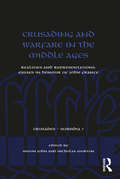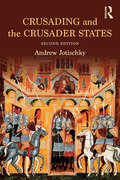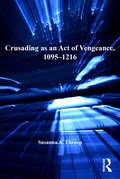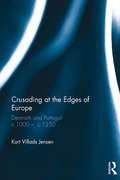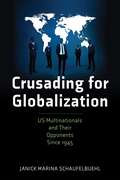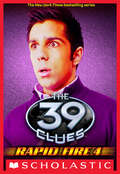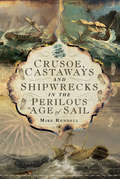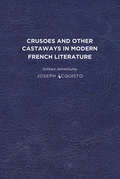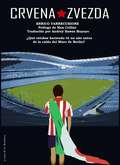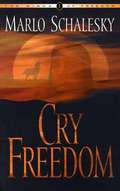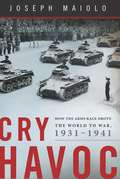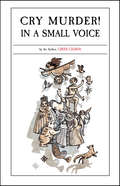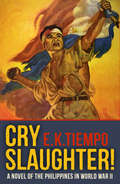- Table View
- List View
Crusading and Warfare in the Middle Ages: Realities and Representations. Essays in Honour of John France (Crusades - Subsidia #7)
by Nicholas Morton Simon JohnThis volume has been created by scholars from a range of disciplines who wish to show their appreciation for Professor John France and to celebrate his career and achievements. For many decades, Professor France’s work has been instrumental in many of the advances made in the fields of crusader studies and medieval warfare. He has published widely on these topics including major publications such as: Victory in the East: A Military History of the First Crusade (1994) and Western Warfare in the Age of the Crusades (1999). This present volume mirrors his interests, offering studies upon both areas. The fifteen essays cover a wide variety of topics, spanning chronologically from the Carolingian period through to the early fourteenth century. Some offer new insights upon long-contested issues, such as the question of whether a new form of cavalry was created by Charles Martel and his successors or the implications of the Mongol defeat at Ayn Jalut. Others use innovative methodologies to unlock the potential of various types of source material including: manuscript illuminations depicting warfare, Templar graffiti, German crusading songs, and crusading charters. Several of the articles open up new areas of debate connected to the history of crusading. Malcolm Barber discusses why Christendom did not react decisively to the fall of Acre in 1291. Bernard Hamilton explores how the rising Frankish presence in the Eastern Mediterranean during the central medieval period reshaped Christendom’s knowledge and understanding of the North African cultures they encountered. In this way, this work seeks both to advance debate in core areas whilst opening new vistas for future research.
Crusading and the Crusader States (Recovering the Past)
by Andrew JotischkyCrusading and the Crusader States explores how the idea of holy war emerged from the troubled society of the eleventh century, and why Jerusalem and the Holy Land were so important to Europeans. It follows the progress of the major crusading expeditions, offering insights into initial success and subsequent failure, charts the development of new attitudes towards Islam and its followers, and shows the effects of the Crusades on society and culture in the Near East. Providing analysis and discussion of this vital period of medieval history, Andrew Jotischky discusses key questions such as how crusading evolved in theory and practice, how crusading expeditions were planned and carried out, why they were considered such an essential part of medieval society, and why their popularity endured despite military failures. This new edition takes into account the wealth of rich and varied recent research to show why crusading should be seen as central to the European experience in the Middle Ages. It engages with key historiographical debates of the past decade, including how Crusades were formed, the political culture and social networks of crusading, and the effects of crusading on western religious and aristocratic culture. It now extends into the fifteenth century to discuss the lasting ramifications of the Crusades, and illustrate their legacy into the early modern period. It is essential reading for all students of the Crusades and medieval history.
Crusading as an Act of Vengeance, 1095–1216 (Studies In Performance And Early Modern Drama Ser.)
by Susanna A. ThroopOnly recently have historians of the crusades begun to seriously investigate the presence of the idea of crusading as an act of vengeance, despite its frequent appearance in crusading sources. Understandably, many historians have primarily concentrated on non-ecclesiastical phenomena such as feuding, purportedly a component of "secular" culture and the interpersonal obligations inherent in medieval society. This has led scholars to several assumptions regarding the nature of medieval vengeance and the role that various cultures of vengeance played in the crusading movement. This monograph revises those assumptions and posits a new understanding of how crusading was conceived as an act of vengeance in the context of the twelfth and early thirteenth centuries. Through textual analysis of specific medieval vocabulary it has been possible to clarify the changing course of the concept of vengeance in general as well as the more specific idea of crusading as an act of vengeance. The concept of vengeance was intimately connected with the ideas of justice and punishment. It was perceived as an expression of power, embedded in a series of commonly understood emotional responses, and also as an expression of orthodox Christian values. There was furthermore a strong link between religious zeal, righteous anger, and the vocabulary of vengeance. By looking at these concepts in detail, and in the context of current crusading methodologies, fresh vistas are revealed that allow for a better understanding of the crusading movement and those who "took the cross," with broader implications for the study of crusading ideology and twelfth-century spirituality in general.
Crusading at the Edges of Europe: Denmark and Portugal c.1000 – c.1250
by Kurt Villads JensenThis book is the first to compare Denmark and Portugal systematically in the High Middle Ages and demonstrates how the two countries became strong kingdoms and important powers internationally by their participation in the crusading movement. Communication in the Middle Ages was better developed than often assumed and institutions, ideas, and military technology was exchanged rapidly, meaning it was possible to coordinate great military expeditions across the geographical periphery of Western Europe. Both Denmark and Portugal were closely connected to the sea and developed strong fleets, at the entrance to the Baltic and in the Mediterranean Seas respectively. They also both had religious borders, to the pagan Wends and to the Muslims, that were pushed forward in almost continuous crusades throughout the centuries. Crusading at the Edges of Europe follows the major campaigns of the kings and crusaders in Denmark and Portugal and compares war-technology and crusading ideology, highlighting how the countries learned from each other and became organised for war.
Crusading for Globalization: US Multinationals and Their Opponents Since 1945 (American Business, Politics, and Society)
by Janick Marina SchaufelbuehlThe first book to shed light on what caused corporate executives to pursue a pro-globalization agenda over the last eight decadesCrusading for Globalization tells the story of an extraordinarily influential group of business executives at the helms of the largest US multinational corporations and their quest to drive globalization forward over the last eight decades. Janick Marina Schaufelbuehl argues that the spectacular expansion of international investment, trade, and production after 1945 cannot be understood without considering the role played by these corporate globalizers and the organization they created, the US Council (today’s United States Council for International Business). By shaping governmental policy through their congressional lobbying and close connections to successive presidential administrations, US Council members, including executives from General Electric, Coca Cola, and IBM, among others, consistently fought for ever more market deregulation, culminating in the creation of the World Trade Organization in 1995.Crusading for Globalization is also a book about those who opposed the growing might of multinationals. In the years immediately after World War II, resistance came from business protectionists, before labor and policymakers from the Global South joined the effort in the early 1970s. Schaufelbuehl breaks new ground by offering a panorama of this early anti-globalization movement, and by showing how the leaders of multinationals organized to limit its political influence. She also examines continuities between this early movement and the opposition to globalization that emerged at the beginning of the twenty-first century from the left and the populist right and discusses how business responded by promoting corporate social responsibility and voluntary guidelines.The first book to shed light on what caused corporate executives to pursue a pro-globalization agenda and to examine their methods for dealing with their opponents, Crusading for Globalization reveals the historical roots of today’s disparities in wealth and income distribution.
Crusading in the Age of Joinville
by Caroline SmithCrusading in the Age of Joinville enhances the current literature dealing with the issue of crusaders' motivations by providing a detailed examination of the ideas and experiences of those who promoted and participated in the crusades of Louis IX of France in the mid-thirteenth century. It assesses the possibilities and problems associated with the source material available to historians of crusading in the thirteenth century and highlights the unique nature and value of John of Joinville's Life of Saint Louis. Two distinct approaches are taken to the analysis of these sources in order to demonstrate their richness. The first of these is thematic and is employed to reveal contrasts between the idealised images of crusading depicted by its promoters and the experiences of those who responded to their calls to take the cross. Secondly, the careers of Joinville and his close contemporary Oliver of Termes provide extended case studies demonstrating that involvement with crusading could have very different origins and expressions. Overall, Crusading in the Age of Joinville provides an innovative and accessible study of crusaders and crusading in the thirteenth century.
Crusading in the Long Nineteenth Century, 1798–1928: Engaging the Crusades, Volume Ten (Engaging the Crusades)
by Adam KnoblerEngaging the Crusades is a series of concise volumes (up to 50,000 words) that offer initial windows into the ways in which the crusades have been used in the last two centuries, demonstrating that the memory of the crusades is an important and emerging subject. Together these studies suggest that the memory of the crusades, in the modern period, is a productive, exciting, and much-needed area of investigation.Crusading in the Long Nineteenth Century offers a trans-cultural examination of “crusade medievalism”, that is, the use of the symbolism and rhetoric of the crusades in the popular and political discourse of the long nineteenth century. Using a variety of sources, from missionary accounts to children’s literature, this book includes an examination of “crusade medievalism” through the politics of a European-wide audience, from states which could claim some relationship to medieval crusading, to those regions where crusading was not part of a national historical heritage. It also examines how the Islamicate world looked upon the crusades in the nineteenth and early twentieth centuries.By looking at the phenomenon of “crusade medievalism” from a multi-national perspective, this volume is of interest to medievalists, modernists and those interested in the crusades in general.
Crushed (The 39 Clues: Rapid Fire #4)
by Clifford RileyThe fourth of seven brand new 39 Clues stories, leading up to one explosive reveal. Ian Kabra has an embarrassing secret. It's not that he once accidentally ate at Burger King. It's not that he still has his childhood teddy bear, Mr. Buttons. It's that he can't stop thinking about a certain grubby American orphan. But just when he's about to take action, a dangerous person from his past stages a dramatic midnight break-in, forcing Ian to accept that there's something worse than an embarrassing crush---a secret that won't stay buried.
Crusoe
by Katherine FrankIt is January 1719 and Daniel Defoe, almost sixty, sits at a table, writing. He is troubled with gout and debt, but for now is preoccupied with a younger man on a barren shore – Robinson Crusoe, for which he will principally be remembered. Several miles south, an old man, Robert Knox, is bent over a heavy volume. It is Historical Relation, his account of being held captive on Ceylon, published forty years ago after he escaped and returned to England. It has long been out of print, but a copy perhaps sits on the desk of Daniel Defoe as he writes. Where did Crusoe come from? And what is the secret of his endurance? Crusoe explores the intertwined lives of two real men – Daniel Defoe and Robert Knox – and the character and book that emerged from their peculiar conjunction. It is the biography of a book and its hero, the story of Defoe, the man who wrote Robinson Crusoe, and of Robert Knox, the man who was Crusoe.
Crusoe's Daughter
by Jane GardamIn 1904, when she was six, Polly Flint went to live with her two holy aunts at the yellow house by the marsh - so close to the sea that it seemed to toss like a ship, so isolated that she might have been marooned on an island. And there she stayed for eighty-one years, while the century raged around her, while lamplight and Victorian order became chaos and nuclear dred. Crusoe's Daughter, ambitious, moving and wholly original, is her story.
Crusoe's Daughter
by Jane GardamIn 1904, when she was six, Polly Flint went to live with her two holy aunts at the yellow house by the marsh - so close to the sea that it seemed to toss like a ship, so isolated that she might have been marooned on an island. And there she stayed for eighty-one years, while the century raged around her, while lamplight and Victorian order became chaos and nuclear dred. Crusoe's Daughter, ambitious, moving and wholly original, is her story.
Crusoe, Castaways and Shipwrecks in the Perilous Age of Sail
by Mike Rendell&“Fascinating&” stories of real-life people and events that inspired the author of the classic adventure novel Robinson Crusoe (Historical Novel Society). This book looks at some of the stories that inspired Daniel Defoe, author of Robinson Crusoe—stories of bravery, determination, and good fortune, as well as human negligence, sheer stupidity, and bad luck. In addition to an overview of Defoe&’s life and his monumentally successful novel, it also considers some of the reasons why people found themselves cast away—as a result of being wrecked, abandoned as a punishment, or marooned by pirates, or even out of deliberate choice. Major hurricanes in the eighteenth century causing huge damage to shipping and loss of life are also covered, along with catastrophes when ships were lost, and astonishing tales of survival in the face of adversity—down in the Falklands, in the Caribbean, and off the coast of Australia. It looks at how being cast away brings out the best in some—and in others the very worst. And it examines perhaps the most astonishing story of them all—sixty slaves abandoned on a desolate treeless island in the Indian Ocean and left there for fifteen years, some of whom survived against all odds.
Crusoe: Daniel Defoe, Robert Knox, and the Creation of a Myth
by Katherine FrankA remarkable literary hybrid--part biography, part detective story--about the enduring figure of Robinson Crusoe Where did Crusoe come from? Frank explores the intertwined lives of two real men, Daniel Defoe and Robert Knox, and the character and book that emerged from their peculiar conjunction. January 1719. A man sits at a table, writing. Nearly sixty, Daniel Defoe is troubled with gout and mired in political controversy and legal threats. But for the moment he is preoccupied by a younger man on a barren shore--Robinson Crusoe. Several miles south, another old man, Robert Knox, sits bent over a heavy volume--published nearly forty years before. Knox's Historical Relation was a bestseller when it was published in 1681, just a year after he escaped from Ceylon and returned to England. Where did Crusoe come from? And what is the secret of his endurance? Crusoe explores the intertwined lives of two real men, Daniel Defoe and Robert Knox, and the character and book that emerged from their peculiar conjunction. It is the biography of a book and its hero: the story of Defoe, the man who wrote Robinson Crusoe, and of Robert Knox, the man who was Crusoe.
Crusoes and Other Castaways in Modern French Literature: Solitary Adventures
by Joseph AcquistoCrusoes and Other Castaways in Modern French Literature: Solitary Adventures by Joseph Acquisto examines the many ways in which the castaway, particularly in the form of engagement with Robinson Crusoe, has been reinterpreted and appropriated in nineteenth through twenty-first century French literature. The book is not merely a literary history of the robinsonnade in France; rather, Acquisto demonstrates how what he calls the genre of “solitary adventure” becomes a vehicle for exploration of much larger questions about the reception of texts, modes of reading, and the relationship between popular and serious literary traditions. The heart of Crusoes and Other Castaways in Modern French Literature examines a crucial moment in the late nineteenth and early twentieth centuries when the history of cultural perspectives on reading and solitude intersect, catalyzing a reconsideration of Defoe’s tale. Acquisto’s philosophically inflected readings of works by writers from Rousseau to Balzac, Verne to Gide, Valéry to Tournier enhance intertextual and cultural approaches to the castaway myth and broaden our appreciation of the dynamic relation it has to modern French literature writ large. Published by University of Delaware Press. Distributed worldwide by Rutgers University Press.
Cruzadas e os Soldados da Cruz: Os 10 Cruzados Mais Importantes
by Débora Souza Santos Michael Rank10 pequenas biografias dos combatentes mais importantes das cruzadas 'As Cruzadas e os Soldados da Cruz' é um novo livro interessante de autor best-seller e historiador Michael Rank sobre a missão para reconquistar a Terra Santa. Ele observa a vida e tempos das 10 pessoas mais importantes em um dos momentos mais interessantes da história, abrangendo de 1095 a 1212. Quer se trate de Pedro, o Eremita, levantando um exército de 100.000 camponeses para lutar nas cruzadas na Terra Santa com nada além de forcados, ou Balduíno IV pessoalmente liderando suas forças contra Saladino, apesar de sofrer com lepra terminal, estes personagens lendários foram obrigados a abandonar suas extensas posses territoriais para embarcar em uma aventura perigosa contra um inimigo superior. Este livro vai observar as razões que fizeram estas 10 figuras se juntarem às cruzadas. Talvez fosse pela glória nas batalhas, como foi o caso de Ricardo Coração de Leão. Para outros, era simplesmente curiosidade, como Leonor da Aquitânia, que acrescentou a verve dramática à situação e trouxe 300 servas vestidas de armadura decorativa e carregando lanças, enquanto marchavam para Jerusalém. Para muitos, foi uma simples convicção de fé, como os milhares cruzados mirins, que, segundo a lenda, marcharam para o mar Mediterrâneo e esperavam que ele se abrisse para eles como o mar vermelho tinha feito para Moisés. Qualquer que fossem seus antecedentes, estes 10 participantes das cruzadas demonstram que uma pessoa disposta a enfrentar a jornada extremamente perigosa, viajando para a um continente diferente sobre a terra, ainda por cima, tinham uma personalidade adequada para a época fascinante em que viviam.
Crvena Zvezda: ¿Qué estabas haciendo tú un año antes de la caída del Muro de Berlín?
by Enrico Varrecchione¿Y si...?¿Y si el 9 de noviembre de 1988 el árbitro alemán Dieter Pauly no hubiese decidido suspender por niebla el partido de vuelta de octavos de final de la Copa de Campeones entre el Estrella Roja de Belgrado y el Milan en el estadio Marakana de Belgrado? En la niebla de Belgrado, tal como imagina Enrico Varrecchione en su primera novela Crvena Zvezda, el resultado del campo habría eliminado al Milan, y esto le habría impedido seguir su camino hacia la final, que en realidad ganó por 4-0 contra el Steaua de Bucarest. Y si el Milan no hubiese ganado esa Copa de Campeones, entonces quizás habrían cambiado otras muchas cosas a partir del destino político de un hombre que a raíz de ese triunfo en Europa puso las bases de su descenso en el campo seis años después, en 1994.
Cry Freedom (Winds of Freedom, #1)
by Marlo SchaleskyA beautiful Indian woman and an English nobleman's son find love and freedom---then lose both---in this story of the American frontier. An enslaved Kwelik is determined to trust God, whatever the future holds. But embittered Jonathan Grant, believing she has betrayed him, leaves their homestead for the city. Will they find their way back to each other, and to true freedom?
Cry Havoc!
by Nelson D. LankfordIn early March 1861, civil war loomed. By late April, Americans had begun to kill their fellow citizens. Cry Havoc! recounts in riveting detail the events that divided the states and reveals how quirks of timing, character, and place all conspired to transform the nation into a battlefield. Nelson Lankford, author of Richmond Burning, chronicles the eight critical weeks that began with Lincoln's inauguration through the explosion at Fort Sumter and the president's fateful response to it. Before Fort Sumpter, the balance could have tipped in favor of a peaceful resolution. But the groundswell of patriotic fervor that followed convulsed the political and military landscape in ways unimaginable just weeks before. This book addresses the many might-have-beens, both familiar and lesser known. What if Lincoln had shown restraint over Fort Sumter? What if he had delayed the proclaimation calling for troops? Could wavering unionists in the upper South have held the line? A must-read f
Cry Havoc!
by Nelson LankfordA "compact, engrossing narrative"* that vividly reimagines the events that led to the outbreak of the Civil War What separates historian Nelson D. Lankford's engaging examination of the causes of the Civil War from other books on the subject is its willingness to consider the alternative possibilities to history. Cry Havoc! recounts in riveting detail the small quirks of timing, character, and place that influenced the huge trajectory of events during eight critical weeks from Lincoln's inauguration through the explosion at Fort Sumter and the embattled president's response to it. It addresses the what-ifs, the might-have-beens, and the individual personalities that played into circumstances-a chain of indecisions and miscalculations, influenced by swollen vanity and wishful thinking-that gave shape to the dreadful conflict to come.
Cry Havoc: Charlottesville and American Democracy Under Siege
by Michael SignerThe former mayor of Charlottesville delivers a vivid, first-person chronicle of the terror and mayhem of the August 2017 "Unite the Right" event, and shows how issues of extremism are affecting not just one city but the nation itself. The deadly invasion of Charlottesville, Virginia, by white nationalist militias in August 2017 is a microcosm of the challenges facing American democracy today. In his first-person account of one of recent American history's most polarizing events, Michael Signer, then Charlottesville's mayor, both tells the story of what really happened and draws out its larger significance.Signer's gripping, strikingly candid "you are there" narrative sets the events on the ground-the lead-up to August's "Unite the Right" rally, the days of the weekend itself, the aftermath-in the larger context of a country struggling to find its way in a disruptive new era. He confronts some of the most challenging questions of our moment, namely how can we:Reconcile free speech with the need for public order? Maintain the values of pragmatism, compromise, even simple civility, in a time of intensification of extremes on the right and the left?Address systemic racism through our public spaces and memorials?Provide accountability after a crisis?While Signer shows how easily our communities can be taken hostage by forces intent on destroying democratic norms and institutions, he concludes with a stirring call for optimism, revealing how the tragic events of Charlottesville are also bolstering American democracy from within.
Cry Havoc: How the Arms Race Drove the World to War, 1931-1941
by Joe MaioloDid the arms race of the 1930s cause the Second World War? In Cry Havoc, historian Joseph Maiolo shows, in rich and fascinating detail, how the deadly game of the arms race was played out in the decade prior to the outbreak of the Second World War. In this exhaustively researched account, he explores how nations reacted to the moves of their rivals, revealing the thinking of those making the key decisions--Hitler, Mussolini, Chamberlain, Stalin, Roosevelt--and the dilemmas of democratic leaders who seemed to be faced with a choice between defending their nations and preserving their democratic way of life. An unparalleled account of an era of extreme political tension, Cry Havoc shows how the interwar arms race shaped the outcome of World War II before the shooting even began.
Cry Murder! in a Small Voice
by Greer GilmanWinner of the Shirley Jackson Award.London, 1603. Ben Jonson, playwright, poet, satirist . . . detective? Someone is murdering choir boys and Jonson, in the way that only Greer Gilman could write him - "Fie, poetastery." - is compelled to investigate.
Cry Rape: The True Story of One Woman's Harrowing Quest for Justice
by Bill LuedersCry Rape dramatically exposes the criminal justice system’s capacity for error as it recounts one woman’s courageous battle in the face of adversity. In September 1997, a visually impaired woman named Patty was raped by an intruder in her home in Madison, Wisconsin. The rookie detective assigned to her case came to doubt Patty’s account and focused the investigation on her. Under pressure, he got her to recant, then had her charged with falsely reporting a crime. The charges were eventually dropped, but Patty continued to demand justice, filing complaints and a federal lawsuit against the police. All were rebuffed. But later, as the result of her perseverance, a startling discovery was made. Even then, Patty’s ordeal was far from over. Other books have dealt with how police and prosecutors bend and break the law in their zeal to prevail. This one focuses instead on how the gravest injustice can be committed with the best of intentions, and how one woman’s bravery and persistence finally triumphed.
Cry Slaughter!
by Edilberto K. TiempoCry Slaughter!, first published in 1957 is a fictionalized account of guerrilla life in the central Philippines during the Second World War. Filipino author E. K. Tiempo (1913-1996), himself a member of the Filipino resistance to the Japanese occupation, paints a vivid picture of life under the Japanese, and the difficulties faced in deciding to surrender to the Japanese or take to the mountains and form a guerrilla force. As Tiempo states in the introduction to the book, “Cry Slaughter! was based on actual situations, including the central situation of the shooting of the four envoys by the minister in the story. Many incidents in the novel were taken from They Called Us Outlaws, a non-fiction work which I wrote for the Seventh Military District of the Philippine resistance forces, as part of my work as officer in charge of the historical section. Parts of They Called Us Outlaws, (the Japanese labeled the guerrillas outlaws in those days) were used in the trial of Japanese war criminals in Manila after the war. The original manuscript of Cry Slaughter! was taken out of the Philippines in a submarine in 1943 under cover of a Philippine blackout; perhaps it was the only manuscript to successfully leave the Philippines” during the War.
Cry Wolf
by Victoria ThompsonFrom Romantic Times Career Achievement Award Winner and New York Times bestseller Victoria Thompson, a magnificent historical romance... "Ms. Thompson imbues her characters with strength, eloquence and dignity." -Romantic Times When Lobo rides up to the Davis ranch, Rachel feels a tremor, as if the very earth was about to open. Lobo is the wolf hunter that they desperately need, though he seems to Rachel to be as primitive as the wild creatures he tracks--a sure hunter whose home is the wide-open Wild West. And Rachel can't help but hunger for his touch. But she's also heard the legend of the wolf who walked as a man and wonders if Lobo is more than just a man--his power is undeniable. Though the ranch hands respect him and her little boy adores him, Rachel senses there will come a final day of reckoning between the hunter and the hunted--and a night when she will know the passion as savage as a wolf.
